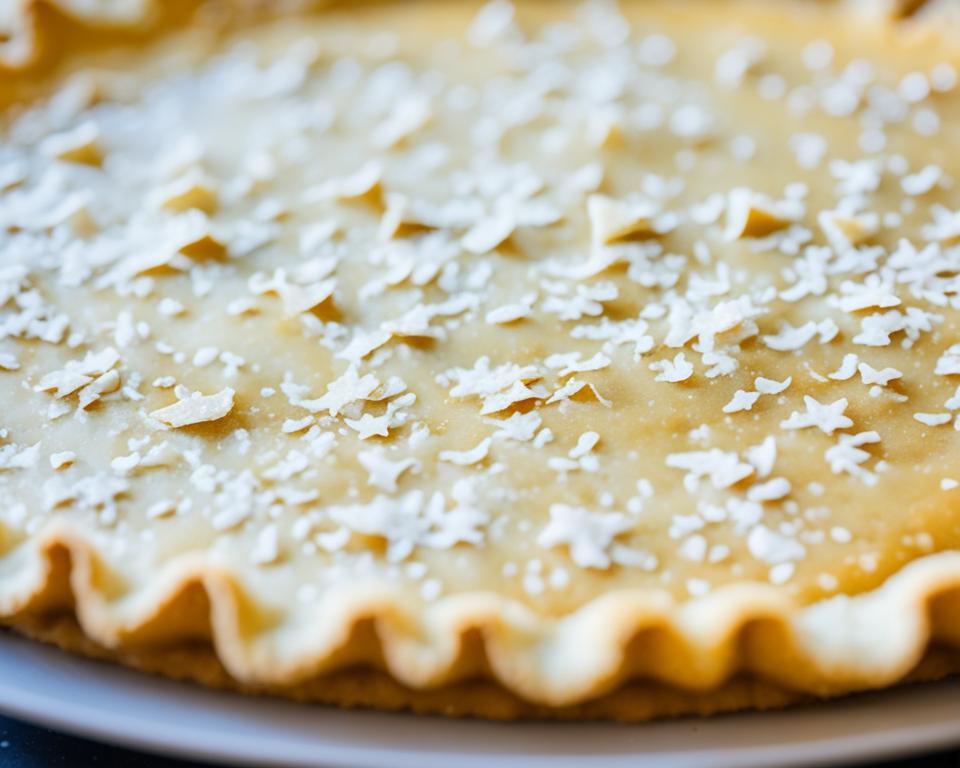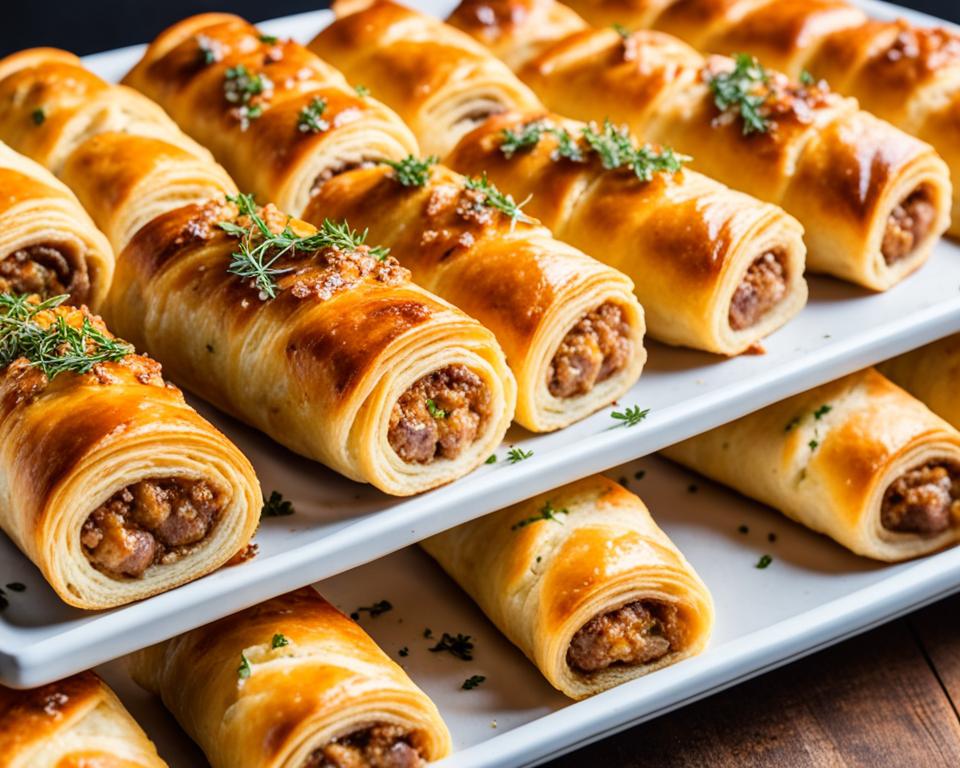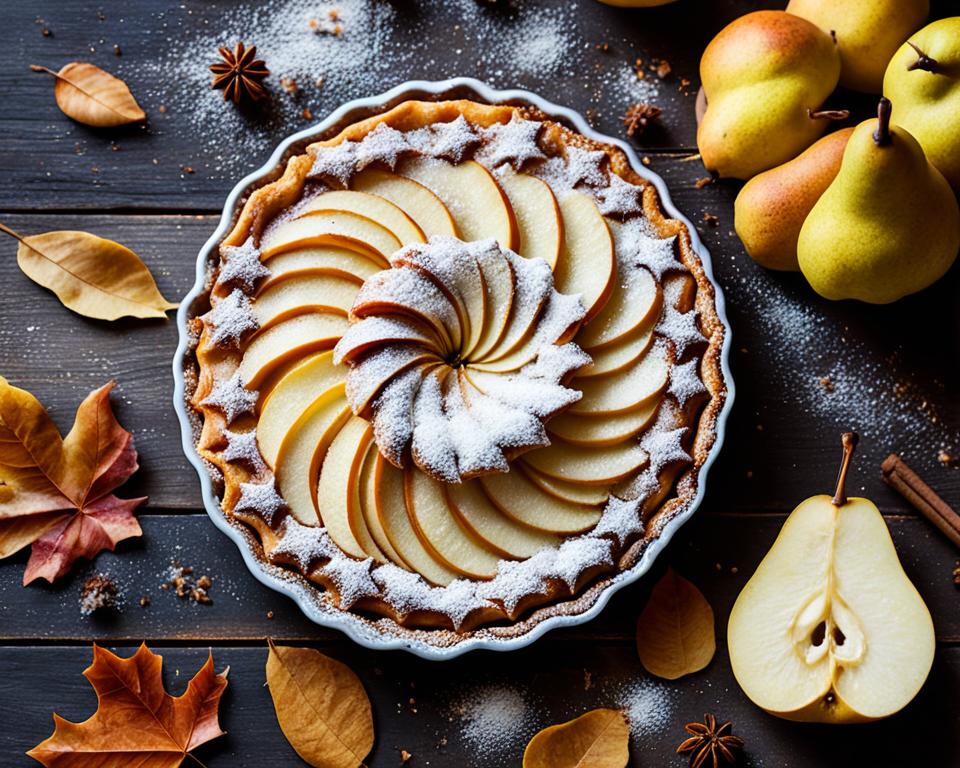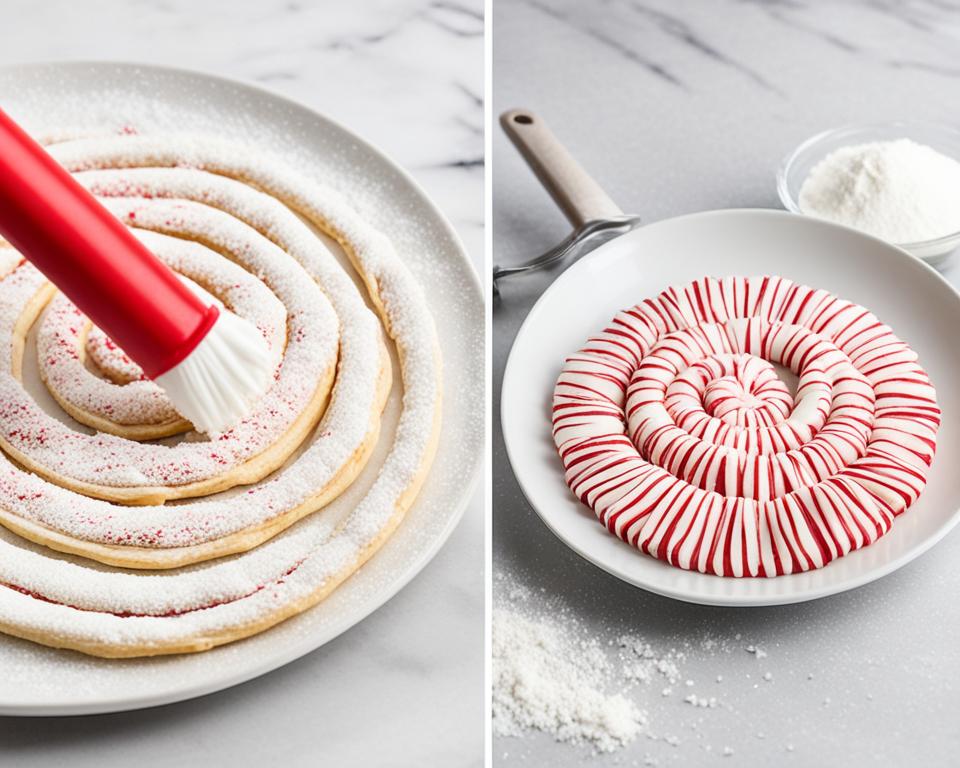If you’re looking to master the art of creating a perfect flaky pie crust, we have you covered. With the help of expert tips and tricks, you’ll be able to make a homemade pie crust that is buttery, flaky, and absolutely delicious. Let’s dive into the details and learn the secrets to a flawless pie crust.
Key Takeaways:
- Get the flour-fat-water ratio right for a successful flaky pie crust.
- Choose the right fat like butter, lard, or shortening for the desired texture.
- Keep all the ingredients cold to ensure the fat doesn’t melt before baking.
- Use proper technique to incorporate the fat into the flour without overworking the dough.
- Add moisture with vinegar or vodka for a flakier crust.
The Flour-Fat-Water Ratio
When it comes to making a pie crust, getting the correct ratio of flour, fat, and water is crucial. Following the right pie crust technique and tips can make all the difference in achieving a flaky and delicious crust. Most pie doughs use a ratio of 3 parts flour, 2 parts fat, and 1 part water. This ratio ensures a balanced and tender crust that holds together well. However, it’s important to add the water gradually and adjust as needed to achieve the perfect consistency. The dough should be malleable but not too wet, allowing for easy rolling and shaping.
Every baker knows that the foundation of a successful flaky pie crust lies in finding the right balance of these key ingredients. This careful balance ensures that the crust bakes evenly, with layers of flakiness that beautifully complement the pie’s filling.
So remember, when preparing your pie crust, pay attention to the flour-fat-water ratio and incorporate pie crust tips and techniques to create a crust that will impress your family and friends with its flaky perfection.
Choosing the Right Fat
The type of fat you use in your pie crust can make a significant difference in its flakiness. Butter is a popular choice for its rich flavor. Some recipes combine butter with lard or shortening to achieve the perfect balance of moisture and flakiness. Lard and shortening are both easy to work with and create tender, flaky layers. Experiment with different combinations to find the flavor and texture that suits your taste.
| Fat | Characteristics |
|---|---|
| Butter | – Rich flavor – Creates a flavorful crust – Adds a buttery aroma |
| Lard | – Easy to work with – Produces a tender crust – Enhances flakiness |
| Shortening | – Easy to handle – Gives a light and flaky texture – Maintains moisture in the crust |
Each fat has its unique characteristics and contributes to the overall texture and taste of your pie crust. Some bakers prefer a combination of butter and lard to achieve a balance between flavor and flakiness. Others opt for a blend of butter and shortening for a lighter and moist crust. Ultimately, it’s a matter of personal preference and the type of pie you’re making. Don’t be afraid to experiment and find the perfect fat combination that suits your pie baking style.
Keeping Ingredients Cold
One of the key secrets to a flaky pie crust is to keep all of your ingredients as cold as possible. This ensures that the fat doesn’t melt before baking, which is essential for creating those desirable flaky layers.
Chill your fats, water, and even flour before starting the dough-making process. The colder your ingredients, the better chance you have of achieving a flaky and tender crust.
To keep your ingredients cold, follow these tips:
- Refrigerate your fats, such as butter or shortening, until they are firm.
- Place your water in the refrigerator for at least 30 minutes before using.
- Store your flour in the refrigerator or freezer prior to making the dough.
By keeping your ingredients cold, you’ll ensure that the fat remains solid until it hits the hot oven, resulting in those buttery, flaky layers that every pie lover craves.
The Importance of Technique
The technique used to incorporate the fat into the flour is crucial in achieving a flaky pie crust. Many experts recommend using a food processor or pastry cutter to ensure the fat is evenly distributed throughout the dough. The goal is to achieve a crumbly texture with pea-sized pieces of fat. Be careful not to overwork the dough, as this can result in a tough crust. Work efficiently and stop mixing as soon as the dough comes together.
Tips for Incorporating Fat:
- Use a food processor or pastry cutter to evenly distribute the fat.
- Aim for a crumbly texture with pea-sized pieces of fat.
- Be cautious not to overwork the dough.
- Mix just until the dough comes together.
| Technique | Description |
|---|---|
| Food Processor | Using a food processor can help evenly distribute the fat and create a crumbly texture in the dough. |
| Pastry Cutter | A pastry cutter is another tool that can be used to cut the fat into the flour, creating pea-sized pieces for a flaky crust. |
Adding Moisture with Vinegar or Vodka
When it comes to achieving a flakier pie crust, you might be surprised to learn that vinegar or vodka can play a vital role in the process. Both vinegar and vodka can add moisture to your pie dough without encouraging gluten development, resulting in a perfectly tender and flaky crust.
While it may sound unconventional, adding vinegar or vodka to your pie dough can help tenderize the mixture, making it easier to work with and yielding superior results. These ingredients act as a secret weapon, ensuring your crust is light, delicate, and full of flavor.
Whether you choose to use vinegar or vodka, rest assured that you won’t be able to taste them in the final product. They work behind the scenes, contributing to the overall texture and consistency of your crust. So go ahead and experiment with this technique to achieve the flakiest pie crust you’ve ever made.
Avoid Overworking the Dough
Overworking the dough is a common mistake that can result in a tough crust. Once the ingredients come together, knead the dough just enough until it is malleable and holds its shape. The more you work the dough, the more gluten develops, and the less likely you are to achieve those desired flaky layers. Work quickly and efficiently, stopping as soon as the dough is ready.
Remember, the key to a successful flaky crust is finding the balance between working the dough enough to integrate the ingredients and develop structure, but not so much that it becomes tough. By handling the dough gently and stopping when it reaches the right consistency, you can ensure a tender and flaky result.
For a visual reference on how to handle your dough, take a look at the table below:
| Dough Handling Techniques | Result |
|---|---|
| Kneading the dough excessively | Tough crust |
| Gently working the dough just until it comes together | Tender, flaky crust |
Egg Wash for a Perfect Bottom Crust
One important tip for a perfect pie crust is to egg wash the bottom before adding the filling. This creates a barrier that prevents the filling’s juices from seeping into the crust and making it soggy. Additionally, if you’re blind baking your crust, be sure to follow the instructions provided to ensure an evenly cooked and crisp bottom crust. Egg washing and blind baking are techniques that can elevate your pie crust game.
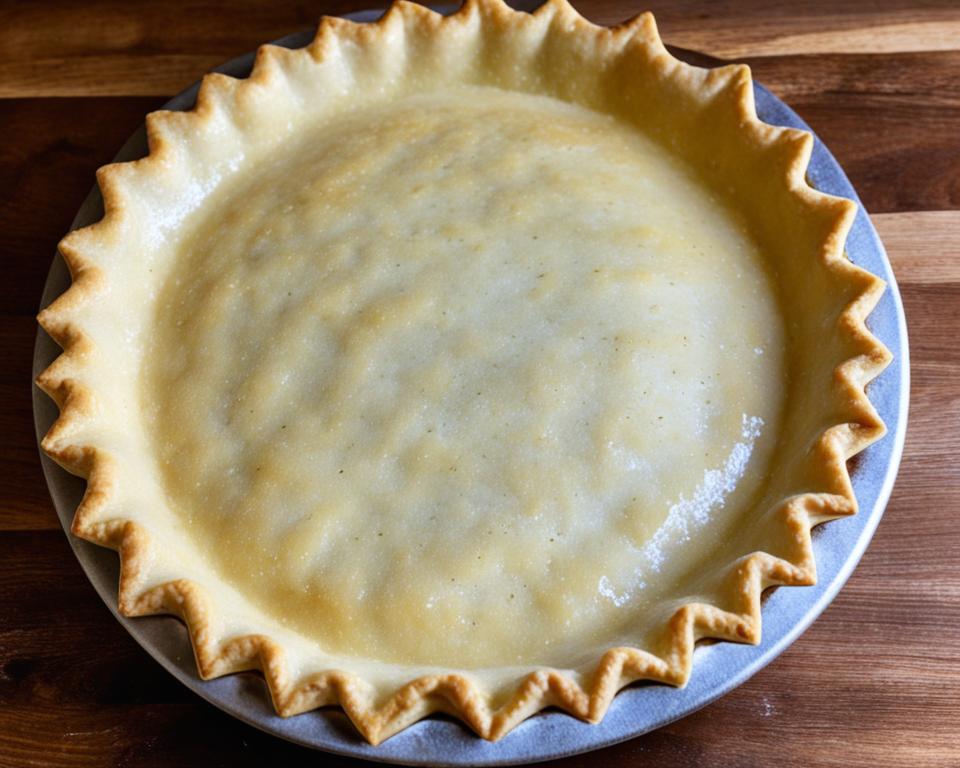
When it comes to achieving a perfect bottom crust with a flaky texture, egg wash plays a vital role. By brushing a thin layer of beaten egg onto the surface of the pie crust before baking, you create a protective barrier that prevents excessive moisture from penetrating the crust. This step is especially important when baking pies with juicy fillings, as it helps maintain the integrity and texture of the crust.
To make an egg wash, simply beat an egg with a small amount of water or milk until well combined. Before applying the egg wash, ensure that your pie crust is chilled and ready for baking. Using a pastry brush or clean fingertips, gently brush the egg wash over the entire surface of the crust, including the edges. This will give your pie a glossy, golden-brown finish.
In addition to preventing a soggy bottom crust, egg wash also adds a beautiful aesthetic appeal to your pies. The golden color achieved during baking adds visual appeal and indicates that the crust is properly cooked.
When blind baking a crust, which involves pre-baking the crust before adding the filling, using an egg wash is an essential step. It helps seal the crust and prevent it from becoming excessively moist when exposed to the filling’s juices. Blind baking with an egg wash creates a sturdy, crisp bottom crust that can withstand the moist filling without becoming soggy.
Overall, incorporating the technique of egg washing into your pie-making process will result in a perfect bottom crust that is both visually appealing and deliciously flaky.
“Egg wash creates a barrier that prevents the filling’s juices from seeping into the crust and making it soggy.”
Conclusion
Congratulations! You’ve now learned all the tips and tricks to create the perfect flaky pie crust. By focusing on the flour-fat-water ratio, choosing the right fat, keeping your ingredients cold, using proper technique, adding moisture with vinegar or vodka, avoiding overworking the dough, and egg washing the bottom crust, you’re on your way to baking homemade pies with a crust that will impress everyone.
With practice, you’ll become a master pie baker and enjoy the satisfaction of creating delicious flaky pies that will leave your family and friends begging for more. Whether it’s a classic apple pie or a savory quiche, your homemade pie crust will be the star of the show.
So roll up your sleeves, gather your ingredients, and get ready to embark on a baking adventure. Put your newfound knowledge to the test, experiment with flavors and fillings, and most importantly, have fun! With each pie you bake, you’ll refine your skills and enhance your ability to create that perfect flaky pie crust everyone loves.
FAQ
What is the correct ratio of flour, fat, and water for a pie crust?
The most common ratio is 3 parts flour, 2 parts fat, and 1 part water. Adjust the amount of water gradually to achieve a malleable but not too wet dough.
What type of fat should I use in my pie crust?
Butter is a popular choice for its rich flavor. You can also experiment with combinations of butter, lard, or shortening to achieve the desired moisture and flakiness.
Why is it important to keep the ingredients cold when making a pie crust?
Keeping the ingredients cold prevents the fat from melting before baking, which is crucial for creating flaky layers in the crust. Chill all the fats, water, and even the flour before starting the dough-making process.
What is the best technique for incorporating the fat into the flour?
Many experts recommend using a food processor or a pastry cutter to ensure the fat is evenly distributed. The goal is to achieve a crumbly texture with pea-sized pieces of fat throughout the dough. Be careful not to overwork the dough.
Can vinegar or vodka be used to add moisture to a pie dough?
Yes, both vinegar and vodka can help tenderize the dough without encouraging gluten development. Add a small amount to the dough, and you won’t be able to taste it in the final product.
What happens if I overwork the dough?
Overworking the dough can result in a tough crust. Knead the dough just enough until it is malleable and holds its shape. The more you work the dough, the more gluten develops, and the less likely you are to achieve those desired flaky layers.
Why do I need to egg wash the bottom crust?
Egg washing the bottom crust creates a barrier that prevents the filling’s juices from making the crust soggy. If you’re blind baking the crust, follow the instructions provided to ensure an evenly cooked and crisp bottom crust.
How can I achieve a perfect flaky pie crust?
By focusing on the flour-fat-water ratio, choosing the right fat, keeping the ingredients cold, using proper technique, adding moisture with vinegar or vodka, avoiding overworking the dough, and egg washing the bottom crust, you can achieve a perfect flaky pie crust every time!

